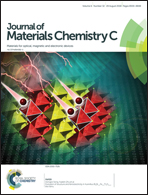Influence of an exciton-delocalizing ligand on the structural, electronic, and spectral features of the Cd33S33 quantum dot: insights from computational studies
Abstract
Quantum dot based solar cells have attracted considerable attention owing to the unique geometrical, electronic, and optical properties of quantum dots. Exciton-delocalizing ligands, such as phenyldithiocarbamate, are demonstrated to benefit charge extraction in quantum dot-based solar cells. However, sufficient details of the exciton delocalization mechanism are still lacking. This work reports theoretical investigations concerning the role of the exciton-delocalizing linker for the ground- and excited-state properties of the Cd33S33 quantum dot. We perform density functional theory and time-dependent density functional theory investigations of the Cd33S33 quantum dot functionalized with two hole acceptors: PTC–PTZ, a phenothiazine ligand with the exciton-delocalizing phenyldithiocarbamate linker, and BA–PTZ, phenyldithiocarbamate with the benzoate linker which is not an exciton-delocalizing ligand. Our calculation results find that PTC–PTZ has two binding modes: bidentate binding and flat binding modes, with the latter being more favorable. The phenyldithiocarbamate linker tends to delocalize the charge densities compared to benzoate. For all complexes, solvent increases electronic band gaps and makes quantum dot-to-quantum dot transitions dominate for the high-energy absorption band. Electron density differences between the excited state and the ground state suggest that the exciton-delocalizing PTC–PTZ molecule, especially the flat binding mode, would induce more significant charge transfer in the direction from the quantum dot to the dye.



 Please wait while we load your content...
Please wait while we load your content...